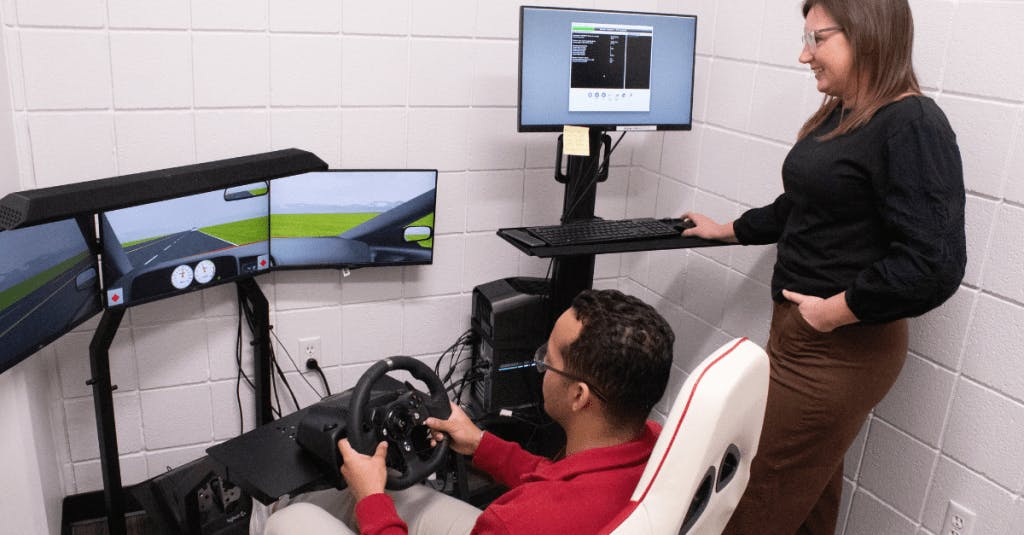Driving is a highly complicated activity that requires a combination of motor, visual, and cognitive skills to avoid catastrophic accidents. But these skills are often impaired after individuals suffer mild traumatic brain injuries or concussions.
In fact, more than 3.8 million concussions occur annually in the United States, but only 44% of concussed individuals reduce their driving. Despite this knowledge, there are no established regulations to ensure post-concussion driving safety.
To help address this issue, a new $1.8 million study funded by the National Institutes of Health (NIH) will analyze the driving of both concussed and non-concussed individuals to provide recommendations for when the concussed group is safe to drive again.

“There are no recommendations or guidelines for clinicians to use to address these questions that patients with concussions have,” said Julianne Schmidt, associate professor in the UGA Mary Frances Early College of Education’s Department of Kinesiology and principal investigator of the study. “We have well-established guidelines for returning to school and sports, but we don’t ever mention driving.”
Evidence of poorer driving performance in first 72 hours
The NIH grant will fund a five-year-long study that aims to strengthen the results from a previous investigation by Schmidt, which found that patients with concussions had poorer driving performance during the acute stage—or first 72 hours of injury—than the non-concussed group.The driving simulation used in the study looked at several factors, including total number of collisions, stop signs missed, lane excursions, total drive time, percentage of time over the speed limit, and percentage of time out of the lane.
Based on these data, Schmidt found that the concussed group committed more lane excursions and speed changes, drove closer to the centerline, and had poorer vehicle control while navigating around a car compared to the non-concussed group.
“Within three days, the concussion group committed more frequent lane excursions and they had greater difficulty with controlling the speed of the car, and they went outside of the lines more often,” said Schmidt. “They were more variable in their speed, which might not seem like that big of a deal, but those are two driving behaviors that have been associated with motor vehicle crash risk from driving simulation research.”
According to Schmidt, the data showed driving patterns associated with risk for motor vehicle crashes within the first few days of concussion.
In contrast, once their symptoms went away, the concussed group drove more conservatively than the non-concussed group, committing less speed changes while navigating through a traffic light.
Once the concussed participants were cleared to return to their sport, the two groups showed no difference in total collisions.
When should individuals with concussions return to driving?
Schmidt’s new study will be conducted at UGA and Emory University and will assess 100 participants before, during, and post-concussion to determine key signs of post-concussion driving performance.“We’ll be able to compare whether their driving is worse or better or the same to their own personalized baseline on the driving simulator,” said Schmidt. “Our driving recommendations about how long people should refrain from driving have to be realistic, and they must balance the social importance of driving. We must find the exact point of recovery, so we can make sure they return to driving as soon as safely possible.”
The need for recommendations is critical because patients with concussions cross the centerline more frequently within the first 48 hours of injury and—as Schmidt’s previous study found—have poorer vehicle control during the first 72 hours when they are still exhibiting symptoms.
In the absence of guidelines for concussed drivers, Schmidt’s study will compare the simulated driving of both groups across five time points: before concussion, on day two, on day four, when participants are asymptomatic, and then again when they receive medical clearance.
The goal of the study is to produce results that will improve the safety of both patients with concussions and the general population by providing the former with appropriate recommendations that avoid stripping them of their independence, which may dissuade future concussion patients from seeking medical care.
On a broader scale, the study can guide the practices of health professionals, inform the future work of researchers, and affirm the work of policymakers.
“Mild traumatic brain injury and concussion haven’t really been extensively studied with motor vehicle crashes outside of a simulator,” said Schmidt. “This is important for every person who takes to the road because these are people that potentially have impairments that are severe enough to make them drive differently, and that doesn’t just affect them.”
“They’re potentially putting every person on the road at risk just like somebody who drives intoxicated. And so, the real broad positive impact is that this goes well beyond just the patient themselves because it helps the patient, it helps the clinician, and it helps everybody who’s on the roadway.”
